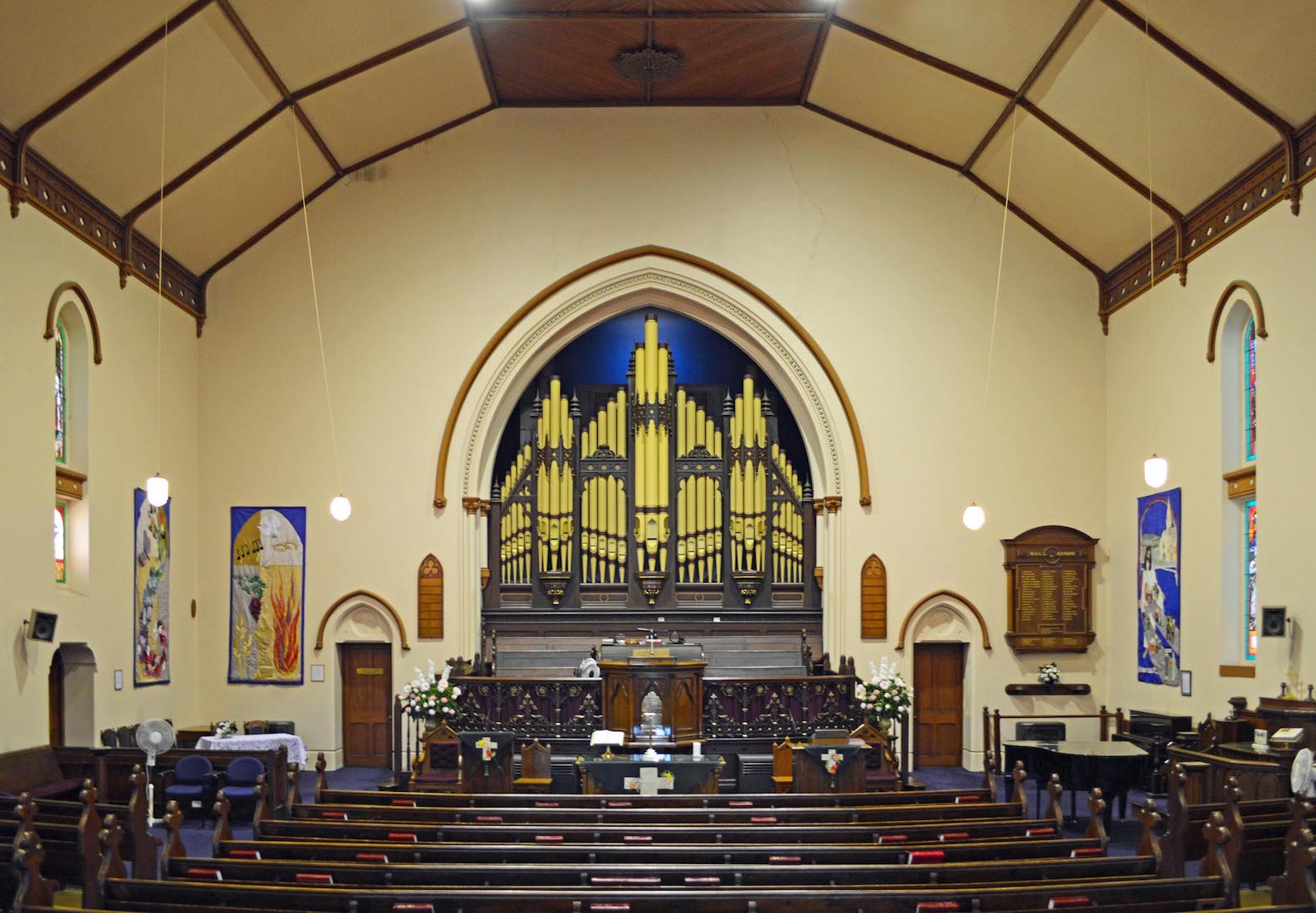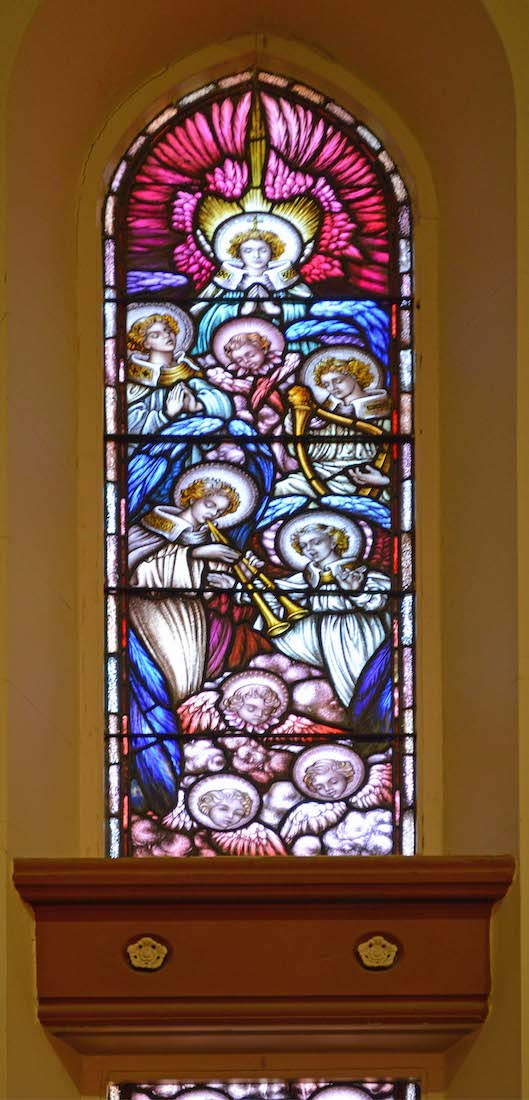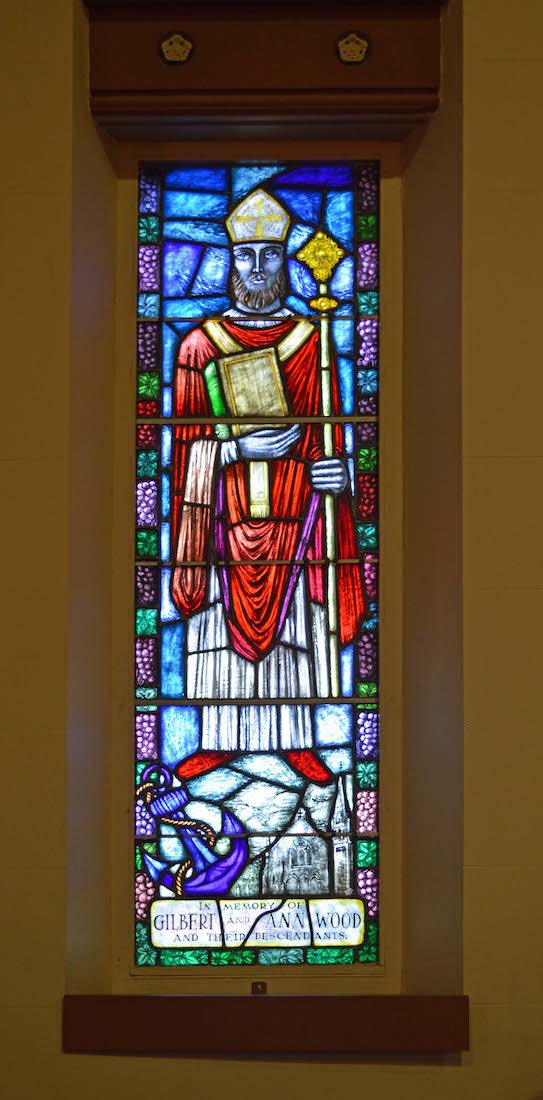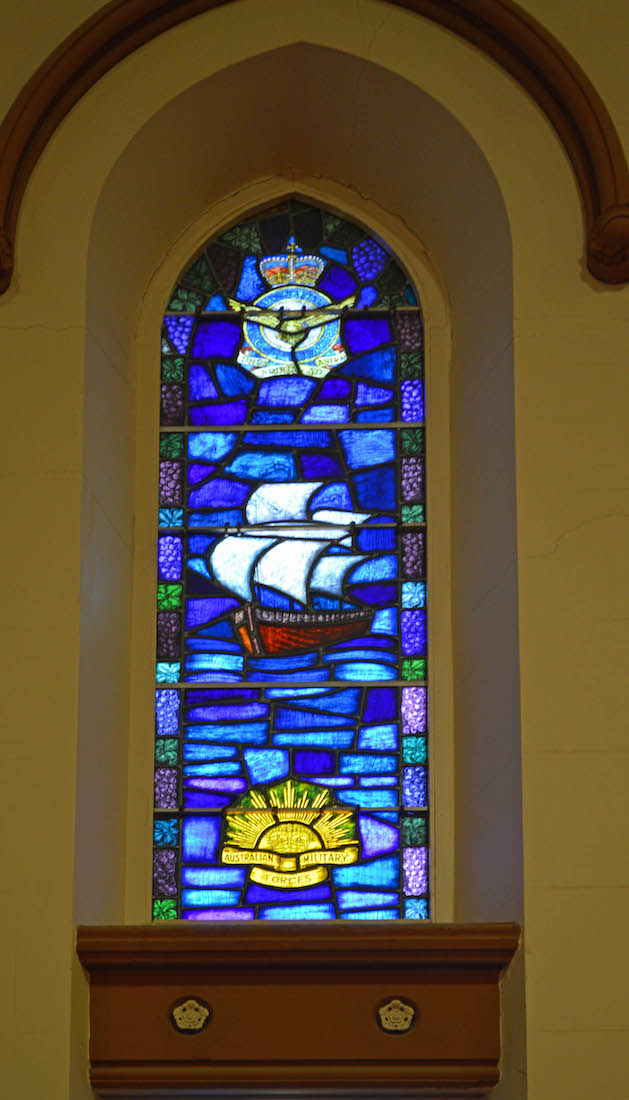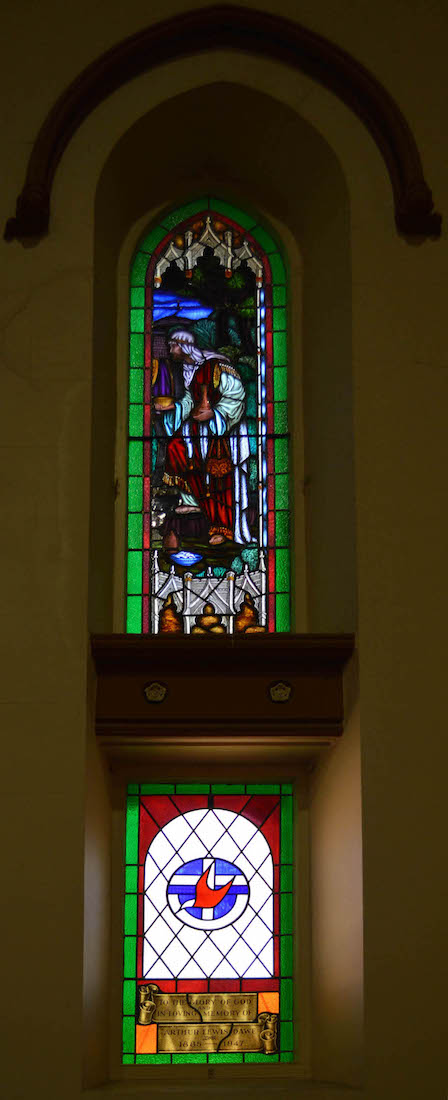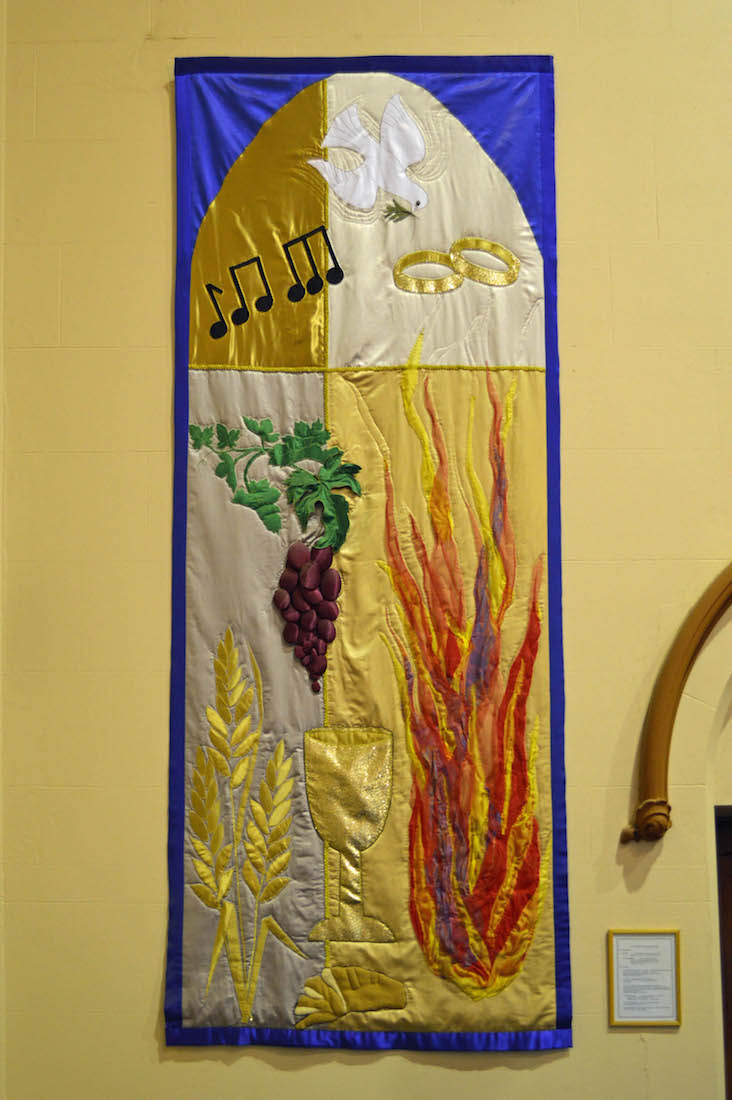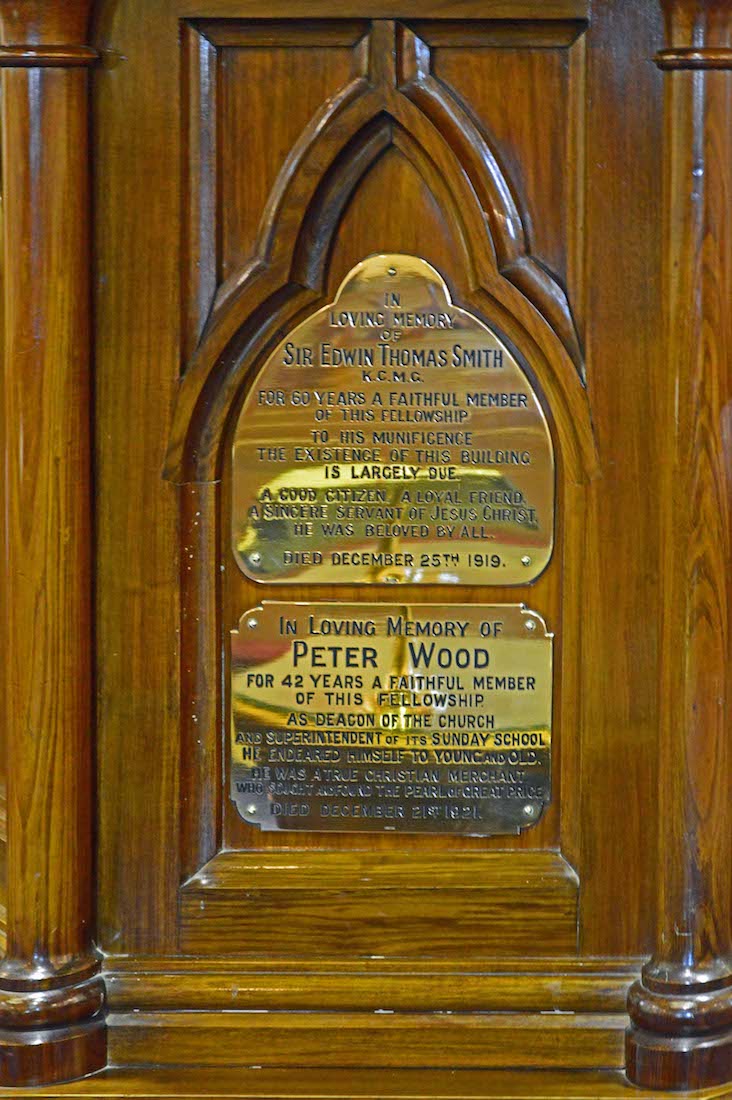

We enter the Church through the North porch. This rather ordinary room contains an old gas furnace in one corner, but is of interest because of the two Honour Rolls found here. The first comes from Newstead Methodist – a church situated in the nearby suburb of St Morris, and which is now the Adelaide Korean Church. The second is the ... INDEX
22. WESLEY HONOUR ROLL
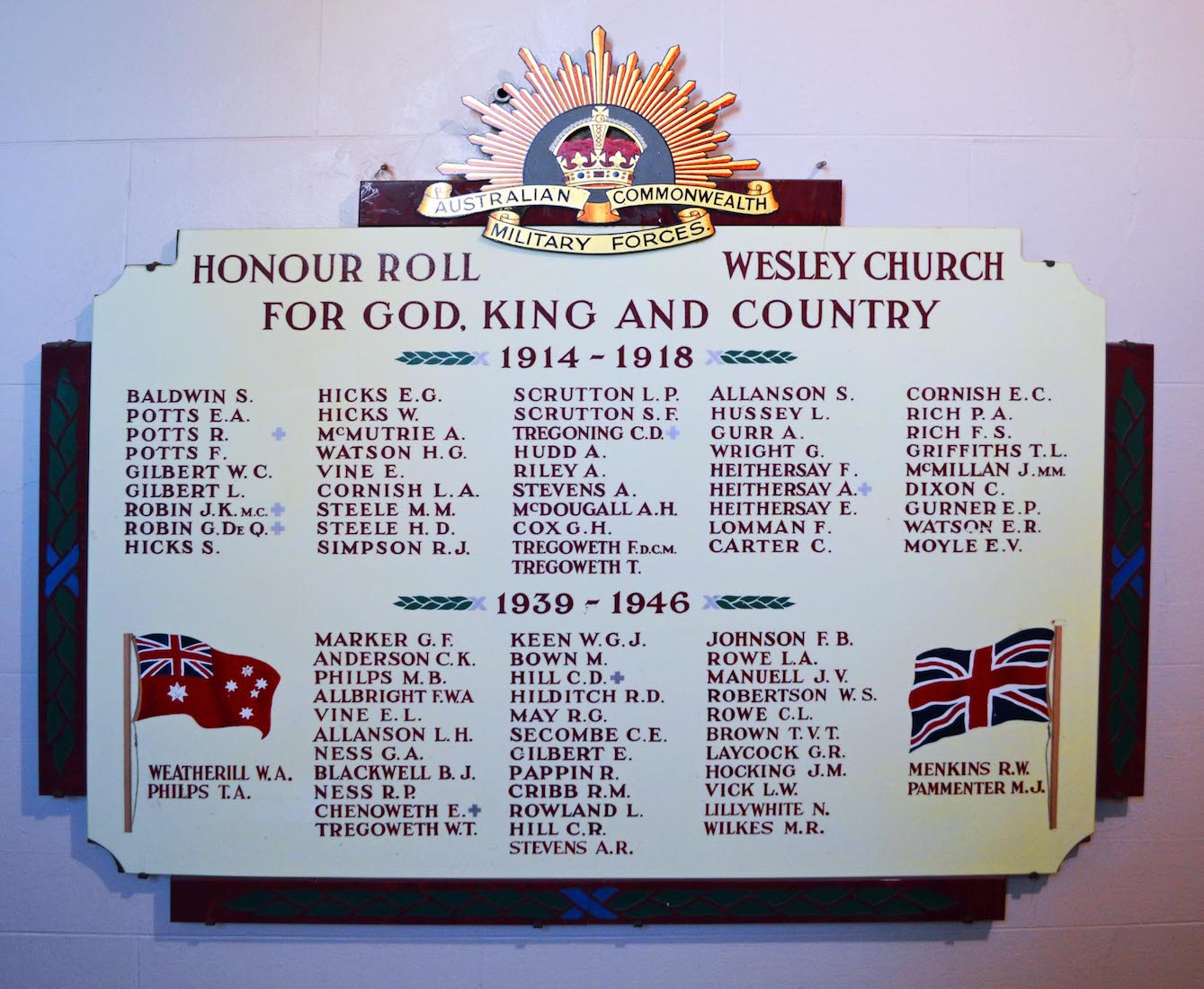
This Honour Roll comes from the Wesley Methodist Church, just opposite the present Clayton-Wesley Church. Clayton-Wesley Uniting Church resulted from the amalgamation of several other churches, and inherited some of their treasures!
24. NAVE ROOF AND FRIEZE
I enjoy looking at the ceilings of these old churches: this ceiling has a wooden central panel with timber planks placed in square designs, and with ceiling roses. Along the North and South edges are decorated wooden friezes.
25. NORTH WALL
We continue our exploration, looking at the windows of the North wall, followed by the corner banners. Some treats here!
26. NORTH WINDOW I
The first window depicts a soldier of Christ, certainly with the words of Ephesians 6:10–18 in mind. The scroll beneath the soldier reads ‘God giveth victory’, and below is a banner reading: ‘Giving thanks to God for the life of Ashley Howard Teece M.C. • Soldier of Christ • Ministering to this church 1909 – 1920’. In his opening address he said he would work to the utmost of his limitations to further the interests of the church and instruct in the Word of God. The noble traditions of the past would be maintained, and he would keep inviolate the teachings of the church.
27. NORTH WINDOW II
This window shows St Ninian, patron saint of the Shetland Islands, birthplace of Gilbert Wood. He was a sea farer and became a merchant in Adelaide, the anchor being his trade mark. The window has a blue (sea) background and a border of grapes and leaves representing the dried fruits industry. Clayton Church spire is there too, the topstone of which he laid at age 55, together with badges which record subsequent family war service. The inscription reads: ‘In memory of Gilbert and Ann Wood and their descendants.’
28. WAR MEMORIAL
Alongside the memorial window to Gilbert Wood we find this memorial which reads: ‘In memory of Gilbert Wood, for many years an active worker in this church, and held the Office of Deacon for 18 years. Died Septr 24th 1886. The memory of the just is blessed. Prov. X. 7.’
29. NORTH WINDOW III
This window was placed in memory of three members of Clayton Church who gave their lives in World War II, namely C. E. Arblaster, R. M. Paterson and M. R. Rose. The unusual design is rich in symbolism – the crown of laurel, the dove, the flags, the globe the clasped hands, and the text: ‘That the nations may be one’. Also included is Laurence Binyon’s verse: ‘They shall not grow old ... ’ from his poem For the Fallen.
30. NORTH WINDOW IV
This window, and the next window to the right, all bordered in green, come from Wesley Church, Norwood. Shown here at top we have the story of the Good Samaritan – or at least that part where the distressed traveller is lying by the road. The head of the Good Samaritan’s donkey can be seen middle right. In the panel below is pictured the Sower, sowing the seed.
31. NORTH WINDOW V
The top window here shows the main character in the Good Samaritan story. The body of his donkey can be seen behind. In their original setting in the Wesley Church, these two windows were placed closer together, and the two parts could be seen making up a whole. The lower window here contains the emblem of the Uniting Church. The dark disk is the world, the white cross stands for redemption, the white dove and red flame signify the Holy Spirit, and the white half-circle the growing unity of Christians. The plaque reads: To the glory of God and in loving memory of Arthur Lewis Dawe 1885 – 1947.
32. NORTHEAST CORNER
We have now arrived at the North East corner of the Church. To the left is the North exit door to the outside. Next are two colourful banners, then a door through to the vestry, and at right a portion of the fine wrought iron railing separating the nave from pulpit and organ.
33. HANDS BANNER
The Hands Banner is officially described as The Reaching out in Friendship, Love and Care banner. It shows the hands of the congregation from the youngest to oldest, swirling round, touching, reaching out in friendship, love and care, and incorporating liturgical colours – purple for Advent and Lent, white for Christmas, green for Trinity, gold for Kingship, and red for Celebration. The four sections of the background join to form a cross. Near the top is a butterfly signifying new life of this congregation resulting from the joining of the St Morris and Clayton-Wesley congregations in 2000. The banner celebrates the first anniversary of this occasion.
34. SACRAMENTS BANNER
Nearby is the matching Sacraments and Symbols banner with a similar background cross. Here we find the sacraments of Baptism (the descending dove) and Holy Communion (bread and wine). The symbols are the Flame of Pentecost, the Vine (Jesus said, ‘I am the Vine’), the Grain, the Music Notes, the Wedding Rings, the Cross, and the Olive Twig (a symbol of Peace).
36. VESTRY PAINTING AND WINDOW
The vestry also contains a colourful painting which is a further reminder of how the Church looked in the early days. The vestry is lit by a very attractive window.
37. CABINET AND RAILING
To the right of the Vestry door stands a glass fronted cabinet containing various old Church memorabilia. Next to it are steps up to the front platform, which is fenced with a very attractive wrought iron railing.
38. FRONT NAVE
There is some space between the front pews and the raised pulpit, and in this area we find a lectern, the communion table, and a reading pedestal. The matching cloths are effective.
39. PULPIT, COMMUNION TABLE, CHAIR
The pulpit bears two brass plaques in memory of Sir Edwin Thomas Smith and Peter Wood for their contributions to Church life. The communion table was presented to the Church in 1958 by the family of Mr and Mrs C, Paterson in memory of their parents. Later, Thelma and Reg Abbott donated the brass cross. And this special chair might well be the cathedra, if Clayton-Wesley had a Bishop!
40. ORGAN
The pipe organ was built and installed by Mr J. E. Dodd in 1897 at a cost of £650. (There are various differing accounts of these early years.) It was enlarged in 1924, and with further improvements became one of the finest organs in South Australia. The later outstanding success of the Norwood Wesley Choir was due to enthusiastic organists and choir-masters. The Choir became well known for its Pleasant Sunday Afternoon musical programs, and in 1936 secured first place in the Open section of the South Australian Centenary Choral Competition.


